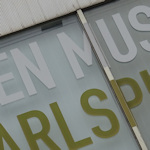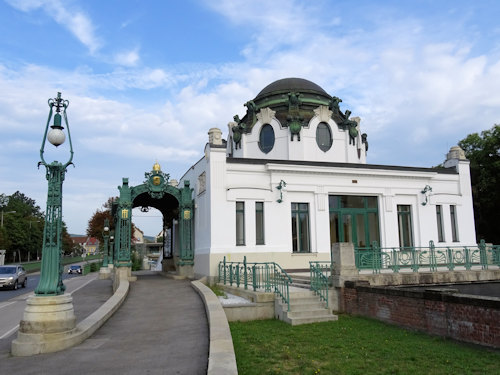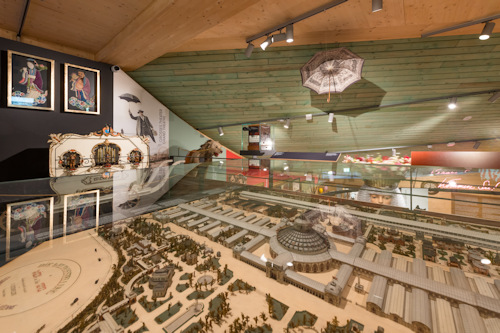
Consider the Wien Museum as Vienna’s own guardian of the city’s culture and history. It manages a whole series of sites, museums, and exhibition venues.
- Around 17 locations throughout the city
- Hosts numerous events and exhibitions across the year
- Portfolio includes various composer residences
- See also:
Wien Museum locations

(The “new” Wien Museum)
The main museum on Karlsplatz square covers Vienna’s own heritage in terms of art, culture, and history. It reopened in late 2023 after a long period of closure for redevelopment.
We now have a lovely modern museum that does an excellent and fascinating job of taking you through a history of the city and its people. This incudes quite a lot of world-class art by the likes of Gustav Klimt.
Follow the links below for individual reviews and visitor tips for the Wien Museum’s other prime locations.
Wien Museum MUSA

(The venue sits opposite one wing of the famous Rathaus city hall building)
An art centre that typically hosts a large exhibition featuring an artist or theme with a strong cultural connection to Vienna.
The MUSA took on some of the exhibition remit of the main site during the rebuilding of the latter, but has now reverted to its conventional raison d’être.
(More on the MUSA and its current exhibitions)
The Hermesvilla
A little summer residence out in the woods that Emperor Franz Joseph built in the late 1800s for his wife, Elisabeth. “Little” if you’re a monarch, “big” if you’re not.
The surrounding Lainzer Tiergarten is a large city-run nature reserve with deer, wild boar, wild sheep and more.
(More on the Hermesvilla)
Otto Wagner Hofpavillon

(This was Wagner’s only imperial commission)
The architect, Otto Wagner, designed various railway station buildings in his time. This 1899 one might be the most impressive, with its touch of imperial elegance.
The pavilion served as a private station for the use of the emperor whenever he nipped out to his summer residence at Schönbrunn Palace. He rarely used it, though, resulting in a poor ROI for the royal coffers.
(More on the Hofpavillon)
Otto Wagner Pavillon
Another Wagner station building. This one looks glorious in green, white and gold. It also houses a small exhibition on the architect. The location above one of Vienna’s largest subway stations is the very definition of convenient.
(More on the Karlsplatz pavilion)
Kirche am Steinhof
And yet another Wagner building, this time a quite magnificent and monumental church that many consider Vienna’s finest example of Jugendstil architecture.
No Gothic arches or gilded Baroque statuary here: white and gold with a dash of sapphire blue in a geometric drawing come to glorious life.
(More on the Kirche am Steinhof)
The Beethoven Museum

(Themed displays offer insights into Beethoven’s life, music, and character)
The prime address in Vienna for those wishing to learn more about the iconic composer. Historians believe he probably wrote his famous Heiligenstädter Testament at this location.
The museum has numerous Beethovenesque delights, including a lock of the maestro’s hair.
(More on the Beethoven Museum)
Beethoven Pasqualatihaus
A smaller museum dedicated to the composer, housed in the building where Beethoven wrote his Fidelio opera.
This part of the old town still retains (I think) some of the old city wall fortifications.
(More on the Pasqualatihaus)
The Haydn House

(Also houses a Brahm’s room)
Haydn spent his final years (and period of greatest celebrity) in this residence. A nice little museum where you learn about the composer’s music and life, but also the wider world he lived in.
Many of these musician residences feature original instruments and other memorabilia. The Haydnhaus, for example, has one of Haydn’s own pianofortes.
(More on the Haydnhaus)
Schubert’s place of birth and final residence

(Schubert’s birthplace)
Two small museums dedicated to the musical genius of Franz Schubert. One is in the house where he was born (Geburtshaus), the other where he died (Sterbewohnung).
Pictures of Schubert invariably feature him with trademark spectacles and you might spot a pair in his birthplace.
(More on Schubert’s birthplace and Sterbewohnung)
Johann Strauss Apartment
The King of the Waltz lived here with his family for several years. As with so many of the composer residences, this one also enjoys a connection to a particularly iconic piece of music. Strauss wrote The Blue Danube at this location.
(More on the Johann Strauss Apartment)
The Roman Museum

(The basement has the remains of two officer houses in it)
Viennese history started long before the first Habsburg wandered into town. The Roman camps and settlements known as Vindobona spread over much of today’s first district, for example.
The small Roman Museum introduces you to this history in a delightfully clear and impactful way.
(More on the Roman Museum)
The Pratermuseum

(Model of the 1873 World Fair held in the Prater; press photo: Klaus Pichler, Wien Museum)
Newly (re)opened in early 2024, the museum takes you on a swift journey across the often colourful history of the Prater recreational area. A place of gentle strolls through nature, but also raucous entertainments.
A museum where you can find a nice painting of woodland views and also an advertisement for “the lion man.”
(More on the Pratermuseum)
P.S.
I’ll add to this list as I wander my way through the Wien Museum’s collection of locations. But if you want to see the full roll call, check out the official website.